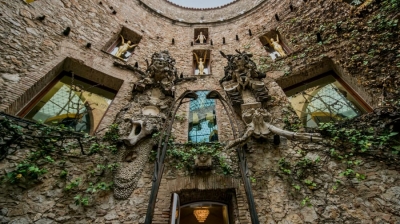MedAssistInternational Ltd
Is this the most unusual museum in Europe?
 16.08.2019
16.08.2019
Filling the former theater with some of his most unique works, such as paintings that seem to transform from different vantage points like "Lincoln in Dalívision," and others which are only visible through secretly placed mirrors, Dalí was able to design his very own museum.
The surrealist fun house opened to the public in 1974 and today makes for a worthy day trip.
Less than an hour train ride outside Barcelona, the Figueres Museum-Theatre offers a respite from the more heavily touristed museums in Spain. The establishment marks the central stop on the the Dalínian Triangle, a route of three significant locations where Dalí lived and produced art, all along the Catalonia region's Costa Brava.
Also on the Dalí' tour: Castle of Púbol, a medieval building located 20 miles south of Figueres, which Dalí renovated as a palace for his wife Gala and the Salvador Dalí House-Museum, 20 miles east of Figueres, in Portlligat (Cadaqués), where he and Gala kept a private coastal residence and workshop.
Said to be the location of his first publicly exhibited art at age 14, the riveting Theatre-Museum is adorned in Dalí's personal history. Even casual fans of the artist should pay a visit to the main museum for a true taste of Dalí's surreal perspective.
Visitors first enter the Dalí Theatre-Museum through a circular open-air courtyard -- originally theater seating -- and in an instant, they're transported into Dalí's imagination.
Parked in the center of the space is Dalí's personal black Cadillac positioned underneath "Gala's Boat": An upside down suspended sailboat painted with blue condoms raining down, mimicking drops of water.
Golden Oscar-esque statuettes fashioned from full-sized mannequins line the surrounding walls of the rotunda. Their arms raised, they appear to be eerily celebrating the creation below.
A glass geodesic dome, meant to resemble the eye of a fly, covers the former stage. Located beneath this is Dalí's grave. In fact, this is where his funeral took place in 1989, and remains his (sometimes) final resting place.
In 2017, his body was exhumed from the crypt as part of a nearly decade long failed paternity case brought by a fortune teller named Pilar Abel claiming to be the surrealist master's daughter and sole heir. Exactly the kind of publicity Dalí himself would have reveled in, the bizarre episode revealed the artist's trademark mustache shockingly remained intact nearly 30 years after his death.
In a 2017 radio interview, Narcís Bardalet, an embalmer who assisted with the exhumation, described the mustache "[like clock hands at] 10 past 10, just as he liked it. It's a miracle," further explaining "the mustache is still there and will be for centuries."
Keeping watch over the front entrance is a diving suit he nearly suffocated in while delivering a lecture in England. With his goal to "dive into the depths of the human subconscious," according to writer Jackie De Burcathe's "Salvador Dali at Home," the artist was forced to pry his helmet free using a billiard cue he also just happened to be holding at the time.
And the award goes to...
One of the main focal points of the Theatre-Museum is the Mae West room -- a space that transforms into a visage of legendary movie star Mae West, with paintings on the wall making up her eyes, a fireplace nose, red-lipped couch and flowing blonde curtains for hair. From a platform overlooking the living room layout, West's famous face takes shape.
Dalí's passion for film is also on display in his collaboration with Walt Disney Studios, the animated short "Destino," which screens at the Theatre-Museum. Production on the short began in 1945, though it wasn't completed and released until 58 years later in 2003 when it was re-discovered by Disney and produced by a team of 25 animators using the original storyboards.




